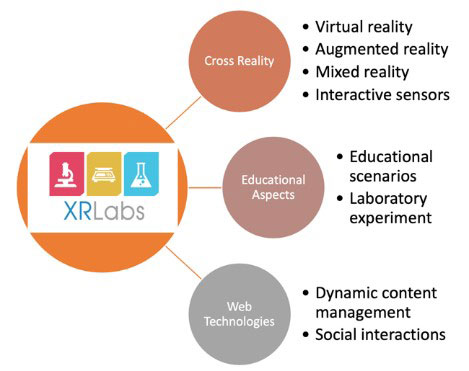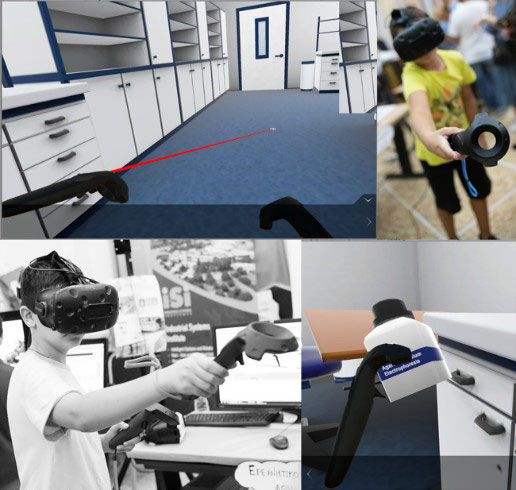by Aris S. Lalos (ISI, ATHENA R.C.), Chairi Kiourt (ILSP, ATHENA R.C.), Dimitrios Kalles (Hellenic Open University)
and Athanasios Kalogeras (ISI, ATHENA R.C.)
XR-LAB envisages developing a highly innovative & interactive extended reality (XR) platform that will empower users, including educators and trainees, to create easily accessible and sustainable edutainment experiences. This will be achieved using holographic interfaces and gamified elements that will develop gradually as familiarity with interactive features is gained. The proposed approach is expected to create convenient, safe, economic, rapid, flexible and user-friendly spaced educational tools that challenge, engage and prepare students for their real scientific experiment in remote STEM education laboratories.
Mixed-reality allows the merging of physical and virtual worlds, creating environments where physical and digital objects co-exist and interact in real-time. It has been used in areas ranging from entertainment and health applications to military training. Extended reality (XR) is defined as a form of mixed reality environment that comes from the fusion of ubiquitous sensor/actuator networks and shared online virtual worlds, to encompass all the possibilities of reality warping technology. Statista reported that social media (i.e., Facebook) had 1.49 billion monthly active users in the second quarter of 2015. Imagine edutainment environments so engaging that people could stay in them for hours and never tire of them! This is where XR comes into the picture.
The role of future XR interactive systems in edutainment
As an emerging technology, virtual, augmented and mixed reality (XR) not only supplements the dynamic notion of the instructional practices but also incorporates sensory modalities, such as, touch, sight and hearing. Several studies reveal the potential benefits of XR in educational contexts, including improving the user’s level of achievement, motivation, knowledge retention and engagement. This technology can also guide targeted behaviour change to improve the way that various activities are undertaken so that the user begins to take the desired actions in different contexts whilst deriving more enjoyment from their tasks [3]. XR technologies are breathing life into the notion that edutainment can be accomplished anywhere; not just within the confines of a classroom. XR is undoubtedly poised to change the way users deliver and acquire information, knowledge, and skills, in playful learning environments [1]. This is bolstered by the rise in popularity of VR and AR devices in Europe, with sales in Western Europe reaching an impressive 283 thousand units of VR/AR head-mounted displays in the second quarter of 2016. According to a recent report published by Allied Market Research, the global mixed reality market was valued at $123.2 million in 2017, and is projected to reach at $5,362.1 million by 2024, growing at a CAGR of 71.6% from 2018 to 2024.
XR technologies in education
Motivation to learn is a complex process, and what motivates on student may not motivate another. Recent studies have shown that personalised edutainment systems improve motivation: students respond favourably to flexible or reduced training/studying hours, course adjustments, or part-time studying and autonomy – all of which are primary areas of intervention for personalised systems [2]. However, we don’t currently know what role these systems play in motivating students to spend more hours acquiring an understanding of complex concepts using laboratory equipment where layouts and modalities are more potent. While multisensorial collaborative edutainment systems hold great potential to improve the interventional aspects of education, very few such systems are used to teach scientific concepts. This means that current interventional “devices” (e.g. virtual assistants, physics based XR interactions and cognitive aware visual analytics) in personalised systems could have both positive and negative educational effects, which, at best, reduces their potential impact (e.g., to induce real knowledge acquisition) and, at worst, might lead to rebound effects (e.g. ironic effects, poor understanding due to information overload or over-trust). If these personalised edutainment systems are to be effective, they undoubtedly require smart incentive mechanisms that offer higher quality experiences, motivating users to engage in creative activities.
The XRLab case
The XRLab is a platform focusing on modern education based on student-centred educational systems with dynamic content, which is not affected by geographical, financial and time constraints, in the way that conventional educational methods are. The proposed platform focuses on laboratory training for all levels of education. Within this framework, the systems under development are based on cutting-edge technologies, such as interactive virtual, augmented and mixed reality environments. The XRLab platform combines three main research areas of Semantic Web, namely: knowledge management in education, gamification and educational systems. Figure 1 depicts the main architecture of the XRLab platform. According the main structure graph, all users (authenticated or not) have basic access (limited) to the systems of the platform. Authenticated users, such as students and teachers, are associated with their status and are given additional services. The main structure of the XRLab includes cutting-edge technologies/methodologies, shown also in Figure 2, focusing on the development of a user-friendly educational environment. An example of the XRLab platform equipped with motion sensing controllers is shown in Figure 3, where students interact with the dynamic object of a virtual laboratory. XRLab follows a user-centred design approach, designing and evaluating the project developments and the overall, integrated XRLab system in realistic conditions in Hellenic Open University. Our main objective during the evaluation phase is to investigate whether students who use the XRLab as a supplement to traditional learning methods learn scientific concepts and experimental skills more easily or if they are cognitively overloaded by the large amount of information, the multiple technological devices, and the complex tasks they have to deal with. The impact of such a holistic approach is huge and the foundations laid here are expected to result in a widespread adoption of sensor-based XR interaction platforms in a wider range of edutainment contexts.

Figure 1: XRLabs conceptual architecture.

Figure 2: XRLabs cutting-edge technologies.

Figure 3: Interaction with VR environment with motion sensing controllers.
This work is supported by the project XRLAB - Virtual laboratories using interactive technologies in virtual, mixed and augmented reality environments (MIS 5038608) implemented under the Action for the Strategic Development on the Research and Technological Sector, co-financed by national funds through the Operational program of Western Greece 2014-2020 and European Union funds (European Regional Development Fund).
Link: http://XRLab.eu/
References:
[1] I. Radu: “Why should my students use AR? A comparative review of the educational impacts of augmented-reality”, in Proc. of IEEE International Symposium on Mixed and Augmented Reality (ISMAR) (pp. 313–314), 2012.
[2] E. Paxinou, et al.: “A 3D virtual reality laboratory as a supplementary educational preparation tool for a biology course”, European J. of Open, Distance and E-Learning, 2018
[3] K. Gardelis, A. Lalos, K. Moustakas: “Development of an Eco-Driving Simulation Training System with Natural and Haptic Interaction in Virtual Reality Environments”, in Proc. of the 13th Int. Joint Conf. on Computer Vision, Imaging and Computer Graphics Theory and Applications - Vol. 2: HUCAPP, pp. 94-101, 2018. ISBN 978-989-758-288-2
Please contact:
Aris S. Lalos
ISI, Athena Research Centre, Greece











